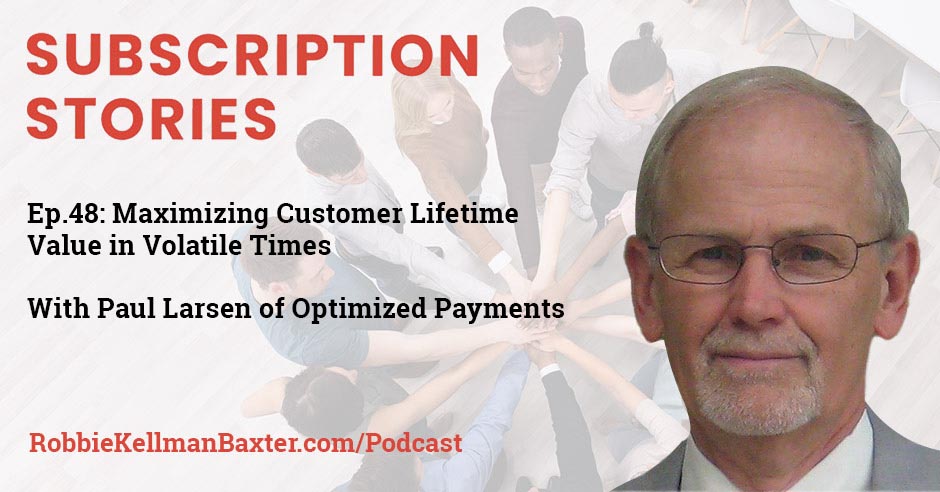
The single biggest source of churn might surprise you.
It’s not a communications issue, or a product/market fit issue, or even an onboarding problem.
The biggest driver of churn in most consumer subscriptions is what’s known as passive or involuntary churn.
Involuntary churn is when a customer is canceled due to a payment issue or other technical problem.
According to ProfitWell CEO Patrick Campbell, a recent guest on Subscription Stories, involuntary churn makes up 20-40% of overall churn.
Many organizations don’t even track passive churn, and that’s a mistake, because there are ways to manage.
Today’s guest, Paul Larsen of Optimized Payments, is one of the leading experts on “card not present” payments, and works with many of the largest subscription businesses in the world on churn management. He launched his career at Reader’s Digest, one of the earliest and largest subscription publications in the world. When Paul started, churn management focused on getting people to renew their subscription by mailing in a check. Since then, he has been deep in the world of credit cards, debit cards and alternate payments, helping subscription merchants reduce costs and increase customer retention.
In our conversation, we talk about why so many good subscribers end up in the dreaded “do not honor” bucket, who should own passive churn in the organization, and how to bring together the right team to manage involuntary churn.
—
Listen to the podcast here
Maximizing Customer Lifetime Value in Volatile Times with Paul Larsen of Optimized Payments
The single biggest source of churn might surprise you. It’s not a communications issue or a product market fit issue or even an onboarding problem. The biggest driver of churn in most consumer subscriptions is what’s known as passive or involuntary churn. Involuntary churn is when a customer is canceled due to a payment issue or other technical problem. According to ProfitWell’s CEO, Patrick Campbell, a recent guest on the show, involuntary churn makes up 20% to 40% of overall churn. Many organizations don’t even track passive churn, and that’s a huge mistake, because there are ways to manage IT.
My guest, Paul Larsen of Optimized Payments is one of the leading experts on card-not-present payments and works with many of the world’s largest subscription businesses on churn management. He launched his career at Reader’s Digest, one of the earliest and largest subscription publications in the world. When Paul started, churn management focused on getting people to renew their subscriptions by mailing in a check.
Since then, he has been deep in the world of credit cards, debit cards, and alternative payments, helping subscription merchants reduce costs and increased customer retention. In our conversation, we talk about why so many good subscribers end up in the dreaded Do Not Honor bucket, who should own passive churn within the organization, and how to bring together the right team to manage involuntary churn.
—
Paul, welcome to the show.
It’s truly a delight to be here, Robbie. Thanks for inviting me.
Before we even dive in, I would love for you to explain to the audience how you think about customer lifetime value and why it’s so important, especially right now.
Customer lifetime value is the reason for having subscriptions or memberships in the first place as far as I’m concerned. It’s the total worth to a business of a customer over the entire period of their relationship. It’s driven by how long the relationship lasts and how much revenue it generates. I exist in this world to do everything I can to mitigate the threats against lifetime value. There are two overarching threats to customer lifetime value. Active churn, also known as voluntary churn, is where a customer proactively takes action to terminate the relationship. Passive churn, also well known as involuntary churn, is where an unintended event threatens to end the relationship.
You’re an expert on many things, but especially on passive churn. It’s an arcane topic. Can you talk about involuntary or passive churn and how you got involved in that world and became an expert?
Arcane is an interesting word. Arcane applies to the subscription business, in general. We think of it in terms of being a tsunami in the past ten years or so. We’ve always been in a subscription-accepting culture all the way back to Ben Franklin who had subscriptions to Poor Richards Almanac. For me, it’s ironic because, out of college, I began working for the world’s largest subscription company for twenty years. I was in a company in which 100% of the churn was passive because credit cards were not yet on the scene. Therefore, every one of their 22 million annual subscribers had to take positive action to renew their subscriptions. Otherwise, they dropped off.
What is this company called? What did they do? What were the payments? There were no credit cards, so were they writing you a check once a year?
It’s a magazine. At that particular point in time, it was the largest direct marketing company on the planet. Few people under the age of 60 would have any appreciation for how gargantuan and how large of a role it played in American life. It was Reader’s Digest and it had 22.5 million subscribers. Every one of their customers though had to renew annually by sending in a check, money order, or something like that. That was crazy.
Counterintuitively then, I was hired from the world’s largest subscription company to a near startup whose goal was to revolutionize the magazine industry by introducing the concept they called Continuous Service. We got a patent for that. It’s auto-renewal tied to a credit card. I come over to this company, Synapse, knowing nothing about credit cards, other than the one I had in my wallet back in 1993.
I also knew that in Synapse, we all loathe it when a hard one-subscriber relationship would crash and burn when neither party asked for that to happen. I was commissioned by them to spend every waking hour mining the payment’s ecosystem for tools and weapons that could be brought to bear in the war against passive churn.
I’ve been in this battle since 1993. Ten years after I joined, Synapse was acquired by Time Warner. When I saw how much more effective at mitigating and minimizing churn we were at little old Synapse, I decided to take this churn-crushing show on the road. Thank God, eighteen years and 700-plus customers later, we’re still fighting passive churn. It’s an ever-changing landscape, but it does contain more than a few subscriptions-destroying land mines.
You pointed out that active churn or voluntary churn is when the customer terminates the relationship. They say, “I don’t like your subscription anymore. I’m not reading your magazine. I don’t get to your gym. I don’t have any more money. I don’t want to spend my discretionary money on this.” Involuntary churn is the credit card stops working or I forget to write my check or update my credit card information, and as a result, the relationship died. Most companies focus a lot on active churn, “Let’s improve the product. Let’s improve the messaging. Let’s tell people how great our product is and get them to use it so they stay.” Why is passive churn such a big deal?
It hurts so much because neither party asked for it to happen. The elements that cause passive churn are both micro and macro. They are related to both individual events that happen to consumers, as well as seminal events that affect greater swats of society.
Passive churn hurts so much because neither party asked for it to happen. The elements that cause it are individual events that happen to consumers and seminal events that affect society. - @PLCPayments Share on XHow big is passive churn as a problem compared to active churn? You work with a lot of organizations that are trying to manage passive churn. How big a problem is this relative to the whole churn issue versus active churn?
For our customers, it’s a bigger problem than active churn.
Is it more than half of the churn?
More than half, yes.
It’s a big deal. People don’t want to leave.
Yes, but when you think about it from the individual level, I’ve been to Citi Field to watch a Mets game and a credit card fell out of my wallet. I had to call when I got home and have it reissued. Meanwhile, every subscription that I had charged to had to that credit card was now subject to potential passive churn because the card would need to be reissued with fresh credentials, which my subscription companies didn’t have on file yet. That’s a micro version.
On a macro version, consumer payment information is being compromised all the time, sometimes stolen in massive data breaches. As a result, their cards may need to be shut down and reissued on a more massive scale. There’s something that can happen on a micro basis or a macro basis like with insufficient funds. Insufficient funds are never going to go away. They’re going to increase or decrease depending on things like the economy. A single customer may be over their credit limit for a myriad of personal reasons. On the other hand, the economy at large may be deteriorating such that there are many more insufficient funds occurrences in the ecosystem, which is the case right now.

Passive Churn: Insufficient funds will never go away. They will only increase or decrease depending on the economy.
I appreciate how you’ve broken down some of the elements that drive passage churns. There are micro issues. I dropped my credit card and now I need a new one for all the subscriptions that I’m subscribed to. Each of those merchants has to have a new credit card or new information. Also, the macro issues, where there was a data breach at Visa or my bank, and as a result, all the credit cards were compromised.
There are also things that have to do with operations like that, but there are also bigger trends that are going on in the world like everybody is struggling with less money and inflation. We used to be stuck in our houses and loved watching streaming content all day long, and now that we can go outside again, maybe we’re not as willing to spend to have multiple streaming services. Maybe you can walk us through the players and help break it down. There are the subscribers and then there are the merchants or the companies that offer the subscriptions. Who else do we need to understand in order to understand how to manage passage churn?
In the payment ecosystem, no one engages Visa and MasterCard directly. There’s an intermediary required between the merchant as they submit transactions into the networks and the networks themselves. Nothing goes directly to Visa. They all go through what’s known as merchant acquirers. They are the only ones that are licensed and sponsored to directly access the credit card networks. We’re talking about companies like Chase Paymentech, FIS Worldpay, Fiserv First Data and Adyen. That’s the only required entity now.
Every merchant needs one of those. Even when you step up to the cash register and use a credit card at Walmart, that transaction is going through an acquirer to Visa or MasterCard. Some merchants choose to insert a gateway between themselves and an acquirer. Sometimes out of ignorance, but oftentimes for ease of connectivity.
It sounds like you’re saying they bought something, subscribed to something or are paying for something that they shouldn’t.
It’s not necessarily that they shouldn’t or that they don’t necessarily need to. Many of them have chosen to use a gateway because the gateway’s connectivity model, their API as they call it, is simpler to code to. The gateway has done the harder job of coding to the acquirer, which can be a heavier lift than just coding to a gateway. You’ve heard of them. They are companies such as Stripe, Braintree, and Cybersource.
They say to merchants, “We make it easier for you to connect to an acquirer. You don’t have to do the heavy lifting. We’ve done that connectivity for you. We have a simpler record layout and code to that, which makes it easier to get onto the networks.” Every merchant has to decide for themselves whether or not they want to code directly to an acquirer or to a gateway.
When you do use a gateway, the gateways aren’t going to do anything for free. That’s an extra cost and it might be worth it. You have to make sure that nothing is being lost in translation as your merchant passes the transaction to a gateway that’s then going to turn around and pass it to an acquirer who’s going to then pass it to the network.

Passive Churn: Make sure nothing is lost in translation as you pass your transaction merchant to a gateway, who will pass it to an acquirer, who will finally pass it to the network.
There’s one more handler of the transaction. In this day and age, most of them have learned how to make that connection flush so that there’s not that much lost in translation along the way, but there are more handoffs on the way into and back from the Visa, MasterCard, Discover, and American Express networks.
You have the Visa and MasterCard networks and the gateways which are optional.
The gateways are optional. The acquirers are required.
There are a couple of other players that come in like the billing systems, especially in the world of subscriptions, these are your Recurly, Zuora, and Vindicia.
They are merchants, great and small, who determined that it’s not worth their while to maintain an in-house billing system. They want to concentrate on the marketing and building out their services or products so they outsource this important functionality to a third party that engages the merchant, acquirers and gateways on the merchant’s behalf.
For each of these players, there’s the possibility of driving churn at each of these stages.
At the end of the day, you can imagine if I have an in-house billing system and I’m connected directly to an acquirer, which is virtually the horse’s mouth because they’re the ones that are connected directly to Visa and MasterCard, I’m in control of my own destiny. I control the transactions and do whatever I want.
If I’m going to use a third party, the Recurly, Zuora and Vindiacias of this world, they are handling lots of transactions for lots of different merchants like me across lots of different gateways and acquirers. You have to do the due diligence to make sure the things that you need from them are not compromised by all of that varied functionality across different platforms that you don’t need. Does that make sense to you, Robbie?
Yes. These payment vendors can have a huge impact on your revenue. They’re not just operational support. Depending on how they’re optimized and how you set them up, it can have an impact on your customer’s lifetime value.
Incredible because they’re the ones that are handling the transactions on your behalf. Hopefully, they’ve built into their platforms the tools and weapons that are necessary for subscription success. You’ve got to monitor that and make sure you’re getting the highest level of best practices for recurring success as possible. They have a huge impact.
If you got to outsource to a third party like Vindicia, Recurly or Zuora, it’s important also to make that decision with your processor in mind. Every marquee billing platform has a connection with every marquee acquirer. However, not all of those integrations are always kept up to the latest technical spec from those acquirers. You want to make sure that you do all that you can to create the best match possible between your billing platform and your acquirer or processor.

Passive Churn: Create the best match possible between your billing platform and the marquee acquirer or processor.
It’s important that they’re all aligned and understand what’s going on because there are so many processes, rules and regulations. Not to mention people like you and me who lose a card or forget to update something.
We’re independent so we want to make sure that our customers end up with the best possible partners for them. It’s about transactional integrity and cultural melding. There’s a lot to consider when selecting an acquirer or a billing platform. We help our merchants create a scorecard that helps lead them to the best platform, and a separate one if they’re looking for a processor.
A merchant needs to develop a dual scorecard, which will help lead them to the best platform processor match if, in fact, they’re going to outsource their billing platform. It’s a big decision. We help a lot of merchants with their build versus buy decision so that they’re making a good decision about whether or not to build their own billing platform or continue to bolster it as opposed to divesting themselves of it, and the PCI burden that comes along with it, and keeping everything up to speed to counter all of the challenges associated with capture over time.
The causes of churn expand and contract and expand again over time. Insufficient funds have always been there and always will be. It’s just a matter of degree. Several years ago, a few would’ve guessed the ramifications of prepaid cards on customer lifetime value. The impact of prepaid has been palpable for some, especially companies serving hard good subscriptions.
Either yourself or in conjunction with your acquirer and your billing platform, you need to determine your approach to say, “Accepting prepaid cards,” whether to accept them, decline them, accept reloadable-only, or accept non-reloadable, the big decisions. You need help from your partners to be able to gatekeep those kinds of things.
This is so interesting. What I’m getting is it’s complicated and there are a lot of players and different methods of payment that are happening at any point in time. This is resulting in more than half of the churned subscribers that any merchant is dealing with. In some cases, passive churn is acceptable like insufficient funds. If I don’t have any money to pay my bills, you should probably stop providing me with services. On the other hand, if I drop my credit card at the ballpark, and it has been a matter of time until I get around to updating my credit card or maybe someone can even do that in an automated way for me, that’s a customer that you don’t want to lose.
Visa and MasterCard are the biggest players at the core of this. What are they doing to bucket or figure out how to categorize the right people to flag from the wrong ones or to bucket the different categories of passive churn? “Paul dropped his credit card. He’s a pretty good guy. He seems to pay on time with a bunch of different subscriptions. We should let him go, but Robbie seems to be more of a shifty character.”
At the highest level, this issue is so profound. You hear terms such as the membership economy or the subscription economy as if inside of it, we were self-aggrandizing. The truth of the matter is here’s a situation in which we have such a profound impact economically that an entire vertical has arisen just to tackle what we call declined salvage. Every merchant has some logic associated with declined recurring transactions that drive the recovery process that they’ve developed.
FlexPay, Butter, Gravy, and Vindicia Retain are companies that help you look at your list of people that are recommended to shut off, and figure out which of them should be kept, how you keep them, and what information you need to keep them.
That’s correct. They are truly salvaged. Hopefully, the merchants have already done smart things themselves to try to recapture potentially passive churn customers. Regarding your question about Visa and MasterCard and what are they doing, it’s interesting that in the payment world, it seems that no good deed goes unpunished.
Merchants have always felt that forces have been aligned against them to make processing more expensive and restrictive as possible. Even when the networks open one hand in a gesture of generosity, they seem to squeeze the other one a little bit more tightly shut. For instance, on the one hand, as long as I’ve been in the business handling declines, merchants have been complaining for decades about card issuers being lazy in categorizing and bucketing their declines. They are quick to put them in a generic bucket with a generic identity which was frustrating to merchants because they’ve got this retry logic.
In the payments world, no good deed goes unpunished. Merchants have always felt that the forces have aligned against them to make processing more expensive and restrictive as possible. - @PLCPayments Share on XAs this generic bucket builds up, they know it’s a cesspool of things. How much better it would be or how much more effective and cost-effective if those had better identities such that the retry logic could be refined, and the people who were recoverable could be gone after, with more wise approaches to processing?
At the end of 2021, after 30 years, Visa and MasterCard finally told issuers, “Stop. We need you to recategorize and redefine declined for what they are.” That’s an open-handed gesture and it was a mandate. This is one of the few times when Visa and MasterCard mandated that their issuers did something. In times past, whenever they approached issuers to be more beneficent to merchants, it would be recommendations, not mandates. They did that now.
At the same time, the networks began to take a hard line on retrying certain declines in certain buckets, which created a unique conundrum because merchants are sitting back and watching all these declines that were generic for decades now being flung into buckets every which way to Sunday. They had no idea if truly hard declines were being thrown into hard decline buckets, which were now being prohibited from retries. That’s an ongoing challenge.
The high-level thing is Visa and MasterCard are trying to do the right thing. They’re trying to say, “Let’s have some categories that we all agree to. We’re going to require you to use them. When you decline somebody, you have to also put a reason to it.” This is not all that different from what CRMs do in terms of describing why you lost this account or labeling things to make it easier for everyone to understand and manage, but it sounds like, it’s not working.
It’s getting there. It’s just that merchants are suffering some travail along the way. You have to understand that this generic bucket or otherwise known in the industry as Do Not Honor is the infamous decline reason code 05, which comes back. Interestingly, for 30 years, Do Not Honor was approximately 50% of all declined recurring transactions. Now, it’s under 10%. The problem is not Do Not Honor anymore, it’s these other buckets in which former Do Not Honor declines have been thrown.
It has been a crapshoot because you have to remember, it’s not as if we have twenty issuers of credit cards which is what we had when the whole decline code structure was created 30 or 40 years ago. We have thousands of issuers from the big banks to the local credit unions, and each of them is taking its best shot at redefinition and re-categorization. It’s all over the map. Our recommendation to merchants, whether their ours or not, is we go with them to their acquirers to consult with them about what they’re seeing of how these new buckets are acting in their ecosystem.

Passive Churn: Join merchants when they go to their acquirers to consult about the declines and new buckets that are acting in their ecosystem.
What we’d also say to our customers and most of our customers is we help develop the internal reporting in which they are monitoring very closely their retry logic. It’s being actively measured by decline and retry attempts. You’re then well-positioned to respond to these new declines or new buckets. You’ll know pretty early on whether or not the tactics you’re using for that new bucket make sense. Measuring your retry logic is important.
In an organization, who should be owning this question of passive churn? Is it the CFO or CMO? Is it a technical issue? Who do you work with when they’re trying to get their arms around their retry logic and the relationship with the vendors?
I’m not being self-laudatory here at all, but of the 700 customers that we’ve had, they’ve almost all come to us. They’ve either felt some pain and googled us or they’ve been at a conference and heard us. Who’s reaching out to us? It’s either the CFO who feels the pain of the lost revenue or the CMO who’s responsible for retention.
Some enterprise-sized companies or the Netflixes of this world have hundreds of people in a department totally devoted to payments operations and success. In small to mid-sized companies, the nagging pain caused by churn finally coerces someone in either marketing or finance to take control. That’s it. We end up as their payment consultant, joining their payments team or their payments task force. That’s a delight for us to be able to do.
Almost from the very beginning, we were fortunate enough to engage one of the largest subscription companies in the US, and they’re located an hour away from us. For eighteen years, we go down there once a month and meet with their CFO who’s concerned about cash, their CMO who’s concerned about the policies and procedures that keep cash being driven to the bottom line, and the CTO because we’re going to talk about refining our strategies, and the CTO is going to have to do the work in order to make the improvements that we need. They all have skin in the game. It’s usually taken control of by the treasury, CFO or CMO.
Ideally, it usually requires all three or some kind of engagement in a task force because there are different levers and insights coming from different parts of the organization.
That’s true.
The last few years have been volatile, to say the least, between this global pandemic and the incredible increase in subscription activity. We’ve seen Peloton, the streamers, and the home meal kits all exploding. News organizations are seeing great growth. Now, we’re seeing the other side of it with inflation, layoffs, and a volatile stock market hurting those same businesses. What has changed and what advice do you have for organizations that are feeling a little bit of whiplash?
All of that is true and it’s real. We monitor the results for all of our customers. There are some sobering data points in play at this particular point in time. The recent report from the Fed, which only goes through June, is we racked up $40 billion in debt in June. That’s the greatest amount ever recorded. Americans have always been debt-oriented so that’s not news.

Passive Churn: Americans have always been debt-oriented. The country racked up $40 billion in debt in June 2022, the greatest amount ever recorded.
We have the second greatest amount of debt on credit cards, $890 billion on credit card debt. It’s accelerating faster than at any other time in the last twenty years. Delinquency and default are on the rise commensurately. We can absolutely confirm the truth of these data in the rise of NSF declines across our entire portfolio from SaaS companies to streaming companies to publishing to a lot of boxes. There’s no merchant, no matter if they’re a Gold Coast file or not, that is not being impacted by higher insufficient funds, declines, or delinquency declines.
We can only take what we experience now and what we read in tea leaves. The Signifyd State of Commerce 2022 Report, which was issued in late July, found that 2/3 of the US consumers plan to continually cut back their spending due to inflationary pressures. This is going to have a serious impact. Subscriptions are great. We love them, but there’s promise and peril associated with them at all times. The economy was good a few years ago, but at that very moment in time when the economy was good, America finally decided they were going to go along with the rest of the world and put chips in their credit cards.
What did that mean? That meant that every card in America was being reissued with a chip. In many cases, those reissued cards had new credentials, certainly a new expiry date, and sometimes new account numbers as well. There’s always friction. You’ve got to be prepared. You have to have your ear on the rail of what’s happening in the world as well as in the payments world to be able to meet the challenges of those new friction items.
You brought up a couple of important things. One is when we have more debt on a massive scale, you can expect cancellations, active churn or voluntary churn, and you can expect an increase in involuntary churn and insufficient funds. Also, every time things change, the rules change. The way that you understand and interpret what’s happening has to change. You may not have systems in place to catch it, like that example of the new chip cards. You can’t plan for that, but you do need to respond rapidly when it happens.
There are tools that have been devised to be able to help you overcome that particular challenge. There is something called the account updater service. The account updater service has been available for twenty years, but for many of those years, not every issuer participated in that. Now, every issuer has to participate in it, but there are ways to engage that account-updater database that are both optimal and sub-optimal. When you think about retry logic, that has to change over time depending on the makeup of the type of declines you have. The same thing to your approach to account updater, these things always used to be unique tools that you use to try to prevent and recover damaged accounts.
Now, it’s so much more important to figure out ways to weave those disparate tools together into a seamless garment as much as possible that will capture as many accounts as possible that are falling off the table. It doesn’t have to be from us. It can be anywhere. Payment audit is important because as you said, the rules of engagement change, therefore the tools of engagement need to be recalibrated. That’s an important thing.
The rules of payment engagement have changed. Therefore, the tools of engagement need to be recalibrated as well. - @PLCPayments Share on XI think back to what you said at the beginning. You spoke about yourself as a fictitious consumer with an insufficient funds situation, and that you may want to have a particular approach with them, maybe even write them off. Yet, if you know for a fact that only 3% of all customers who have insufficient funds go belly up with their card, then that only means that there are still potentially good customers with an active card that’s in a temporary problem.
How do we fix that? We don’t want to throw that out yet. We want to give them a little extra time. How can we systemically do that? There are ways to do that through natural ways of imposing your retry logic and bringing some of these specialized machine learning AI-driven third parties into play. We often recommend that you try one of them in a no strings attached way and see if they work for you after you’ve done all that you can do.
It seems like the advice that you’re giving starts with recognizing that this is not a black box. This is something that can be understood, and not every declined customer is the same. There are lots of different things that you can do. It almost starts by acknowledging that and then you can do an audit, experiment, ask questions of the different players in your ecosystem, and bring them together for a conversation, but it starts with curiosity.
Whether through your partners or yourself, it’s creating nimble approaches to processing. At the end of the day, being aware of these rules. Most of these rules don’t result in losing your license from Visa. They result in mere fines and penalties. In opening this one hand and then closing the other, they’ve created these categories of declines, one of which is, “Don’t ever retry. If you do, we’re going to fine or penalize you a fee of a dime per time you retry a decline that’s from that bucket.” We would say, “Keep that in mind,” but what if it’s true that if I retry those, I’m going to get a 10% effective recovery just by disobeying and doing a few things to massage that transaction?
Being aware of payment rules doesn't result in losing your credit card license. Instead, they result in fines and penalties. - @PLCPayments Share on XResubmit it, I’m going to get a 10% recovery. If I retry $10 and it caused me a dime each, I spent $1, but if it’s a $20 subscription and I recover that 10% of the time, I’m trading in $1 of fees in fines for $20 recovery and the downstream revenue associated with it. That’s why we say it’s very important as much as possible to measure the results of your efforts. Don’t just take everything at face value. You make decisions in the full light of the data.
Be curious, use data, experiment and adjust. That is good advice. You help organizations do that with your company, which has your name on it. You were merged with Optimized Payments. Before we close, can you share a little bit about that acquisition and why it seemed like such a good fit to both of you?
We take encouragement from the fact that a podcast brought us together. I was listening to a payments podcast in which Anand Goel, the Founder of Optimized Payments, was being interviewed. I’m listening to it and thinking to myself, what he’s describing seems to indicate that our two companies are exactly adjacent in functionality with just enough overlap that perhaps each of our core competencies could be complementary and be more than doubly good for the clients in each of our portfolios.
It turned out to be true. We trafficked heavily into each other’s processes and culture for nine months from April 2021 to December 2021. They were a 15-year-old company and we were a 17-year-old company at the time. They were using analytics to help their clients save money. We were using analytics and knowledge to help our customers save customers. They did it through fee reduction. We did it through churn reduction. We have already begun to bring those two disciplines together for our customers’ benefit. Quite frankly, it has been an even better fit than I anticipated. I’m grateful for that.
Congratulations. Do you have a minute or two left for a speed round to close out our conversation?
Sure.
What’s the first subscription you ever had?
It’s Reader’s Digest.
The subscription that you’re enjoying the most right now?
It’s not streaming. It’s not a box. It’s probably my Compassion International subscription, so it’s Support a Child in Poverty. I have a commitment to that which is probably my favorite subscription.
The most underutilized but valuable subscription metric?
This is interesting. It is the recovery success number. Even the biggest and best of our customers, when we meet them, are not measuring it. They have no idea how well or how poorly they’re doing with their recovery logic. As I said, I may sound self-aggrandizing, but this is a big deal. We’ve existed in this for eighteen years and an entire vertical has arisen to help try to overcome the challenge of churn. Yet, after all that is said and done, very few merchants are actually measuring their results.
Recovery is the metric that people should be looking at. For my last question, what’s your favorite thing to do in Alabama?
I live in New York, but my favorite thing to do in Alabama is eating a lot of food that I absolutely can’t get up here and should only eat for the very short periods of time that I visit Alabama. In Birmingham, which is where 3 of my 4 children live. It’s probably one of the more underrated barbecue cities on the planet. They don’t have good pizza.
New York has that covered.
We have that covered. The dead giveaway that the pizza isn’t any good at any particular joint in Birmingham is if it says, “Authentic New York Pizza,” then that’s the one to absolutely avoid, but I love barbecue and I get my fix when I visit our kids in Birmingham.
Paul Larsen, thank you so much for being a guest on the show. I appreciate your wisdom and insights.
—
That was Paul Larsen of Optimized Payments. For more about Paul, go to OptimizedPayments.com. For more information about the show, go to RobbieKellmanBaxter.com/podcast. If you like this episode, please go over to Apple Podcasts and leave a review. Mention Paul in this episode if you especially enjoyed it. Reviews are how people find our show. We appreciate everyone. Thanks for your support. Thanks for tuning in to the show.
Important Links
- Subscription Stories Episode with Patrick Campbell
- Paul Larsen, Senior Director, Optimized Payment
- Optimized Payments
- Synapse
- The Signifyd State of Commerce 2022 Report
- Anand Goel, Founder & CEO, Optimized Payment
- Compassion International
About Paul Larsen
 Paul Larsen has more than 30 years of experience in the Direct Marketing industry. Prior to launching Paul Larsen Consulting, he held a number of Fulfillment and Operations positions at Reader’s Digest and, ultimately, honed his payment processing skills in his decade-long stint as Director of Operations for Synapse Group, Inc., one of the world’s largest magazine subscription companies. Paul is also a past Chairman of both the Direct Response Forum and the Payment Processors Association and presents regularly at conferences such as the DRF, DMA and Marketing Sherpa. He is currently the Senior Director of Payments at Optimized Payments.
Paul Larsen has more than 30 years of experience in the Direct Marketing industry. Prior to launching Paul Larsen Consulting, he held a number of Fulfillment and Operations positions at Reader’s Digest and, ultimately, honed his payment processing skills in his decade-long stint as Director of Operations for Synapse Group, Inc., one of the world’s largest magazine subscription companies. Paul is also a past Chairman of both the Direct Response Forum and the Payment Processors Association and presents regularly at conferences such as the DRF, DMA and Marketing Sherpa. He is currently the Senior Director of Payments at Optimized Payments.
Love the show? Subscribe, rate, review, and share!
Join the Subscription Stories Community today:


